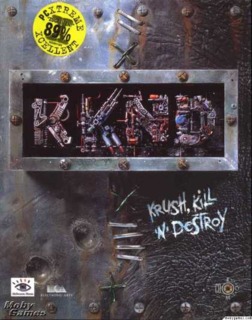Despite the game's interesting (at first) presentation, the novelty doesn't last long.
The plot, what exists of it, seems a tad borrowed from other story lines. After a deadly nuclear war, and after some 40 years of waiting it out, the surviving humans who burrowed underground (and who happened to build up an army, the reason of which the manual has an uninteresting explanation) try and reclaim the surface of the Earth. The Earth is whatever you'd imagine it would be after a nuclear holocaust; mutated flora, twisted and abominable wildlife because of radiation, and what the burrowed humans didn't expect: mutant people. After some disagreements, and the lack of their desire to be friendly, they start a war. The humans are technologically advanced compared to the mutants, who use predominantly living weapons with some man-made firepower to aide in their efforts. The human army is called The Survivors, while the mutant army is called The Evolved. A problem with the gameplay, which is important for this genre, is that the term of "balance" is used to heavily with the units; each time has the exact same kind of unit, only each one has a tiny little strength over the other. The biggest difference between any unit is the highest level of the infantry units, as The Survivors have one of the deadliest units in the game, the Sniper, and the Evolved have a shorter ranged, accurately-declined yet faster shooting Crazy Harry (which is way worse, as a bunch of snipers will easily take out the Crazy Harry's before they even can pull their triggers). This system also lends little play length to the game. Uniqueness, at least a mediocre amount of it, is nowhere to be found in this game. The novelty of the game play wears out after one or two hard-played rounds, forcing you to think if it is really worth playing any longer.
The game does lend very worthy features to the genre, of which have most likely been a benchmark. One feature, which is very interesting and very major to the game itself, is a unit's ability to level up. This is represented by the color of the box surrounding each units' life bars. At gray, the unit as at the normal level; at blue, it is at the 2nd level, and you'll notice accuracy, firepower, and even firing speed increase; the last level is indicated by red, and the unit may shoot twice as fast as it did at the normal level, it will pop a bullet into the head of the enemy much more likely, and it will have a much more sinister sounding voice to boot. The terrain also has a certain amount of interactivity. You can dodge enemy fire when a unit is on the other side of a building from an enemy. Terrain height also serves to keep a unit from even being attacked, and you can gain a strategic advantage from a height. Despite the interactivity though, it doesn't feel real, like the terrain seen even in Command & Conquer, or WarCraft. The game has some mildly redeeming qualities. The mission briefings are every bit in the same vein as Command & Conquer's, which were live-action sequences. These sequences are at times a bit humorous, or somewhat livening, but on the other hand, they just serve to give you the briefing. They have nothing on the stellar work seen in the original Command & Conquer. The music of the game is a bit interesting as well, depending on the level of course, because the game does not have the option to change the music track. Many of the units have interesting lines, some of which can be, "Alrighty then!", "Sure thing", "Yeah, he's so dead", and "He he he he." Like mentioned before though, these elements are merely for novelty. They wear out as quickly as the game play.
KKND Xtreme hardly adds anything new, the most significant of which being the Skirmish mode, called "Kaos Mode" here, and a handful of new missions for each team. These new missions are for the most part extremely frustrating, usually borderline difficult. Not to mention, you don't get anything satisfactory when they're done. You're just brought back to the main menu to do whatever you want afterwards. They also lack any bit of workmanship that had existed in the original game's campaign modes, as there are no live-action briefings. The Kaos Mode is somewhat lacking, though you can have a couple of allies and can enable a special feature, similar to C&C's crate system, where you can gain a very powerful unit or in the worst case scenario, some resource units.
If the game was worked on much more, then it would have been just that. However, it tries to be more ambitious than it should be, as it focuses on introducing it's features, but doesn't execute them very well (other than the leveling up system, which is very good here). It also has a touch of humor that is more of a novelty than originality, and it wears out the game in turn. The game should have avoided the "game balance" overkill, because it took away the chance of uniqueness to the game play. If done a different way, KKND would have been a worthy competitor in this genre.

